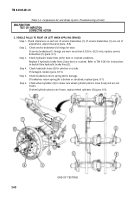TM-9-2320-361-20 - Page 139 of 1207
TM 9-2320-361-20
Table 2-3. Compressed Air and Brake System Troubleshooting.
MALFUNCTION
TEST OR INSPECTION
CORRECTIVE ACTION
WARNIN G
ASBESTOS DUST
Do not use a dry brush or compressed air to clean brakeshoes. There
may be asbestos dust on brakeshoes which can be dangerous to your
health if you breath it. (Brakeshoe must be wet, and a soft bristle
brush must be used.)
PARKING BRAKE
1. PARKING BRAKE WILL NOT HOLD VEHICLE
Step 1.
Step 2.
Step 3.
Step 4.
Check parking brake cable (1) for breaks, bends, or improper adjustment.
a. Replace parking brake cable (1) if broken or bent (para. 8-4).
b. Adjust parking brake cable (1) if out of adjustment (TM 9-2320-361-10).
Inspect parking brakeshoes (5) for wear.
If parking brakeshoe (5) linings are worn more than 0.188 in. (4.78 mm), replace (para. 8-3).
If parking brakeshoe (5) linings and drum (4) are oily, replace parking brakeshoes (para.
8-3) and clean drum (4).
Check parking brakeshoe (5) clearance adjustment (para. 8-3).
If parking brakeshoe (5) clearance is out of adjustment, adjust (para. 8-3).
END OF TESTING!
2. PARKING BRAKE DRAGS
Step 1. Check brakeshoe retracting spring (2) and lever retracting spring (3) for breaks, bends,
missing, or disconnected conditions.
a. Reconnect brakeshoe retracting spring (2) or lever retracting spring (3) if disconnected.
b. If brakeshoe retracting spring (2) or lever retracting spring (3) is broken, bent, or
missing, replace (para. 8-3).
Step 2. Check parking brake cable (1) for binding or improper adjustment.
If parking brake cable (1) is binding or out of adjustment, replace (para. 8-4) or adjust
(TM 9-2320-361-10).
Step 3. Perform step 4 of malfunction 1.
2-54
Back to Top




















